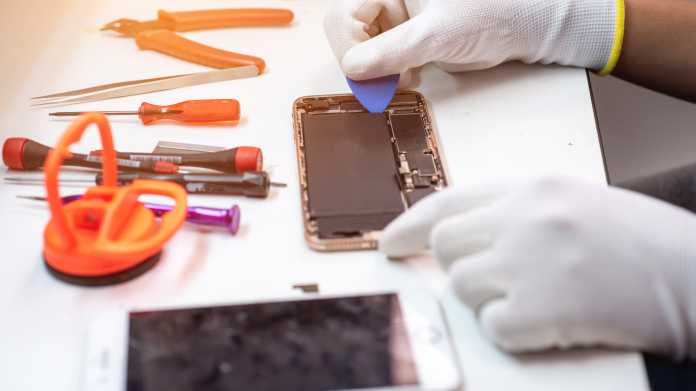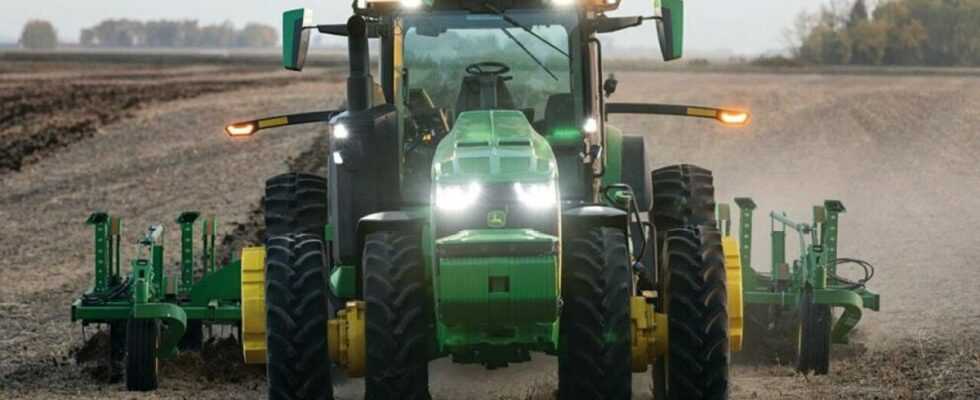For more than 100 years, John Deere’s green-and-yellow tractors have been such a staple of farming, they’ve even been sung about in country songs. While they are more of a symbol of the good old days there, the US agricultural machinery manufacturer has long since arrived in the modern age. At the electronics trade fair CES 2022, he presented his first fully autonomous tractor in early January. The new model in its 8R range is due to be launched later this year and will do its job entirely without a driver.
With this, John Deere wants to help to feed the world population, which will probably increase to ten billion people by 2050, and whose food requirements will increase by 50 percent by then, even in the face of shrinking agricultural land and a shortage of workers. The manufacturer has been working for years to make its machines more autonomous with the help of artificial intelligence and bought two robotics companies with this expertise in 2017 and 2021: Blue River Technology and Bear Flag Robotics.
Authorized tractor repair shops for John Deere machines only
But the fruits of the progressive digitization of agricultural machinery are often sour for customers. While the leading US manufacturers John Deere and Case New Holland as well as Kubota from Japan fetch high six-figure purchase prices for their best machines – John Deere’s 8R 280 basic model of the series costs 320,000 dollars, the most expensive John Deere tractor up to 800,000 dollars these are not fully available to farmers after purchase.

Farmers are not allowed to handle hardware or software problems themselves, as only authorized dealer workshops have access to the proprietary diagnostics and repair software. Independent workshops can only be used to a limited extent, since new spare parts can only be activated by authorized technicians. However, many farmers cannot afford the monopoly moon prices of the manufacturers. Because John Deere, for example, has also cut its workshops in some states, waiting for the technician can, in the worst case, lead to crop failures.
In addition, almost everything in modern agricultural machinery, including starting and calibrating devices, is linked to licensed firmware. As a result, more and more farmers prefer to buy less complicated older second-hand tractors or get hacked firmware to keep their machines running. Because a purchase is often only worthwhile if you can use the vehicle for as long as possible thanks to affordable repairs.
Tractor oldies are still in demand
The demand for models that are easier to repair has more than doubled prices, even for tractors that are more than 50 years old. But that is still significantly cheaper than the new prices for smart tractors. In addition, the oldies can certainly be retrofitted with satellite-based control.
Access to pirated Traktor firmware, which is only available on the digital black market on invitation-only forums, is less easy. Among other things, diagnostic programs, license key generators and cables manufactured by reverse engineering are available here. Legally, hacking your own tractor is a gray area in the US, as agricultural machinery is exempt from the 2015 Digital Copyright Act. In principle, it is not forbidden, but the farmers do not feel comfortable with it. Therefore, many of them fight for the right to repair.

One leader of this grassroots movement is Nebraska agricultural engineer Kevin Kenney. He grew up on a dairy farm and needed to disassemble and reassemble a diesel engine to graduate from college. This is no longer possible with modern tractors. But the activist is about more than just the traditional right to be able to repair one’s own belongings in one of the oldest professions in the world.
What happens to the data from the fields?
He also wants to free farmers from those gag contracts that automatically transmit the data measured by their agricultural machines in the fields – from near-infrared spectroscopic detection of crop components to telematics – via a cellular gateway device to the manufacturer’s cloud. “The US Congress has recognized that agricultural data is a trade secret for farmers. But few people know what rights they are giving up by signing the contract,” Kenney says angrily. He fears that manufacturers are looking to sell this data for another lucrative business.
Kenney has also challenged the tying of machine parts to individual tractor VIN numbers (serialization), which effectively eliminates third-party replacement parts. Apple uses a similar coupling for its batteries, for example. So if a component breaks, only the authorized technician can activate the new component via software.
One model in the fight for the right to repairs is the law passed by the US state of Massachusetts in 2013, which obliges car and truck manufacturers to make their diagnostics and repair software accessible to independent workshops and the owners themselves. By 2021, 27 states already had “Right to Repair” bills for farm equipment, says Gay Gordon-Byrne, executive director of The Repair Association. “The problem of monopolized repair affects not only large-scale grain farmers, but all farmers.”
On the other hand, agricultural machinery manufacturers are likely to face lawsuits, such as the class action lawsuit filed against John Deere in the state of Illinois on January 12. Among other things, the manufacturer is accused of forming a monopoly in repair services and artificially reducing the number of authorized workshops. Without successful lawsuits and “right to repair” laws, little will change for farmers. Because the indictment also quantifies the motivation of the manufacturers: For John Deere and its dealers, components and repair services are three to six times more profitable than selling the original equipment.

(jle)

